
Caffeine benzoate
- 点击 快速询问 获取最新报价。
- 提供有竞争力价格的高质量产品,您可以更专注于研究。
描述
Caffeine benzoate, also known as this compound, is a useful research compound. Its molecular formula is C15H16N4O4 and its molecular weight is 316.31 g/mol. The purity is usually 95%.
The exact mass of the compound this compound is unknown and the complexity rating of the compound is unknown. The storage condition is unknown. Please store according to label instructions upon receipt of goods.Use and application categories indicated by third-party sources: Cosmetics -> Skin conditioning. However, this does not mean our product can be used or applied in the same or a similar way.
BenchChem offers high-quality this compound suitable for many research applications. Different packaging options are available to accommodate customers' requirements. Please inquire for more information about this compound including the price, delivery time, and more detailed information at [email protected].
科学研究应用
Dermatological Applications
Caffeine Benzoate as a Sunscreen Agent
This compound has been studied for its potential as a topical agent that enhances UV protection. Research indicates that it significantly inhibits UVB-induced skin damage, including the formation of thymine dimers, which are precursors to skin cancer. In studies involving SKH-1 hairless mice, topical application of this compound resulted in:
- 90% inhibition of UVB-induced thymine dimers.
- Enhanced apoptosis in UVB-irradiated skin, with this compound showing a 2- to 3-fold greater effect compared to caffeine alone .
Tumor Prevention
This compound has demonstrated efficacy in preventing skin tumors induced by UV radiation. In chronic UVB exposure studies, it was found to inhibit tumor formation and reduce tumor size significantly:
- 76% reduction in the total number of skin tumors per mouse with a 6% concentration of this compound.
- 88% decrease in the number of squamous cell carcinomas .
Psychiatric Applications
Augmentation in Electroconvulsive Therapy
Recent studies have explored the use of this compound as an augmentation agent in electroconvulsive therapy (ECT). In a clinical trial involving 71 patients:
- Administration of 500 mg this compound increased seizure duration by an average of 24.1 seconds , enhancing the efficacy of ECT.
- Patients receiving this compound exhibited improved seizure response rates, which is crucial for effective treatment outcomes .
Neurobehavioral Effects
Impact on Adolescent Behavior
Research has also investigated the neurobehavioral effects of this compound when combined with sodium benzoate in adolescent rats. Key findings include:
- Increased motor activity and improved recognition memory associated with sodium benzoate and caffeine co-administration.
- However, adverse effects on working memory were observed at higher doses, indicating potential risks when combined with processed foods containing sodium benzoate .
Data Summary Table
| Application Area | Findings | Concentration/Method |
|---|---|---|
| Dermatology | 90% inhibition of thymine dimers; enhanced apoptosis | Topical application (6% solution) |
| 76% reduction in skin tumors | Chronic UVB exposure studies | |
| Psychiatry | Increased seizure duration by 24.1 seconds during ECT | Intravenous administration (500 mg) |
| Neurobehavioral Effects | Improved motor activity; recognition memory enhancement | Adolescent rat studies |
Case Studies
-
Skin Cancer Prevention Study
- Objective: To evaluate the effectiveness of this compound in preventing UVB-induced skin tumors.
- Results: Significant reductions in both tumor incidence and size were observed with regular topical applications over an extended period.
-
ECT Augmentation Study
- Objective: To assess the impact of this compound on seizure duration during ECT.
- Results: Patients demonstrated increased seizure durations and improved clinical outcomes compared to those not receiving this compound.
属性
CAS 编号 |
5743-17-9 |
|---|---|
分子式 |
C15H16N4O4 |
分子量 |
316.31 g/mol |
IUPAC 名称 |
benzoic acid;1,3,7-trimethylpurine-2,6-dione |
InChI |
InChI=1S/C8H10N4O2.C7H6O2/c1-10-4-9-6-5(10)7(13)12(3)8(14)11(6)2;8-7(9)6-4-2-1-3-5-6/h4H,1-3H3;1-5H,(H,8,9) |
InChI 键 |
VXXKVQICUHMECR-UHFFFAOYSA-N |
SMILES |
CN1C=NC2=C1C(=O)N(C(=O)N2C)C.C1=CC=C(C=C1)C(=O)O |
规范 SMILES |
CN1C=NC2=C1C(=O)N(C(=O)N2C)C.C1=CC=C(C=C1)C(=O)O |
Key on ui other cas no. |
5743-17-9 |
相关CAS编号 |
8000-95-1 (hydrochloride salt) |
同义词 |
caffeine - sodium benzoate caffeine benzoate caffeine, sodium benzoate drug combination |
产品来源 |
United States |
体外研究产品的免责声明和信息
请注意,BenchChem 上展示的所有文章和产品信息仅供信息参考。 BenchChem 上可购买的产品专为体外研究设计,这些研究在生物体外进行。体外研究,源自拉丁语 "in glass",涉及在受控实验室环境中使用细胞或组织进行的实验。重要的是要注意,这些产品没有被归类为药物或药品,他们没有得到 FDA 的批准,用于预防、治疗或治愈任何医疗状况、疾病或疾病。我们必须强调,将这些产品以任何形式引入人类或动物的身体都是法律严格禁止的。遵守这些指南对确保研究和实验的法律和道德标准的符合性至关重要。















